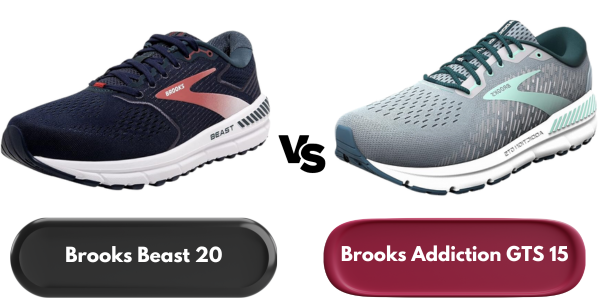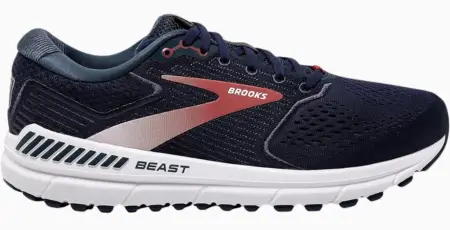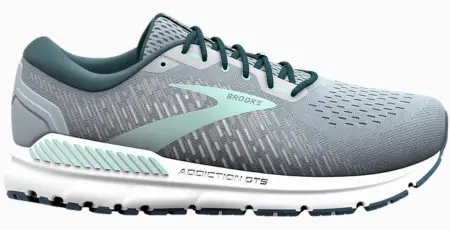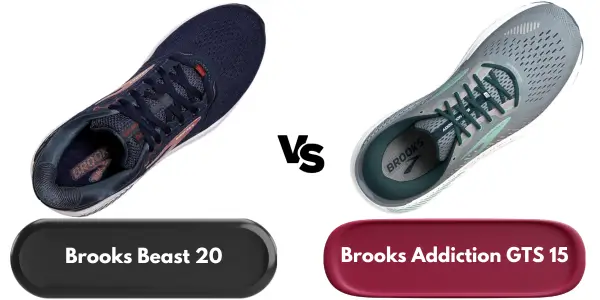Brooks Beast 20 vs Brooks Addiction GTS 15: Road Running Shoes
Last Updated: January 01, 2025 | Author: Jake Thompson
As the saying goes, 'The best things come in pairs,' and that certainly might be the case when we talk about the Brooks Beast 20 and the Brooks Addiction GTS 15.
I've spent countless hours pounding the pavement, and I know that in the universe of shoes, finding the right match for your feet is like finding a needle in a haystack. Both of these models belong to Brooks which is gaining immense popularity for its exceptional products. Our selected shoes are reputed for their exceptional support and comfort, for those who require that extra bit of help with stability.

As I compare the subtle yet significant differences between these two contenders, you'll want to stick around to find out which pair outshines the other when it comes to the intricate balance of cushioning, durability, and control during a run. Will it be the Beast 20's robust build or the Addiction GTS 15's tailored fit that takes the crown?
Let's lace up and find out.
To see how other models in the Brooks range compare, take a look at our detailed review of Brooks Levitate vs. Adrenaline, which offers insights into these popular running shoes.
Table of Contents:
- Key Takeaways
- Table: Brooks Beast 20 Vs Brooks Addiction GTS 15 Running Shoes
- Upper Design Comparison
- Mesh Upper Differences
- Midsole Technologies
- Outsole Supportive Features
- Outsole Traction Comparison
- Flexibility and Movement
- Weight and Cushioning
- Performance
- Stability and Support
- Frequently Asked Questions
Key Takeaways
- - Both Brooks shoes are max support road running shoes suitable for runners and walkers with over or under pronation.
- - The Brooks Beast 20 offers more stability and support, while the Brooks Addiction GTS 15 focuses on motion control and offers plenty of cushioning.
- - The Brooks Addiction GTS 15 has a traditional lacing system and suede overlays, while the Brooks Beast 20 has a wide plush tongue and collar and embroidered structured saddle.
- - The Brooks Addiction GTS 15 is priced at $130, making it a good value option, while the Brooks Beast 20 is priced higher at $160.
Table: Brooks Beast 20 Vs Brooks Addiction GTS 15 Running Shoes
 |
 |
|
|---|---|---|
| Aspect | Brooks Beast 20 | Brooks Addiction GTS 15 |
| Comfort | Plush soft, mesh upper | DNA LOFT sole, comfortable padding |
| Support | GuideRails support, motion-control shoe | GuideRails system, stability, and support |
| Durability | Heavy-duty, motion-control shoe | Supportive and protective, durable design |
| Midsole | BioMoGo DNA and DNA LOFT cushioning | BioMoGo DNA cushioning |
| Upper | Engineered mesh upper with 3D Fit Print | Moisture-managing Element Mesh and synthetic overlays |
| Outsole | HPR Plus rubber | HPR Plus rubber |
| Weight | 11.7 oz | 12.2 oz for men's, 11.1 oz for women's |
| Price |
Check out our comprehensive review of Brooks Beast 20.
Upper Design Comparison
Turning to the upper design, I'll analyze the nuanced differences between the Brooks Beast 20 and the Addiction GTS 15.
I've observed that the Beast 20's upper lining contrasts with the Addiction's suede overlays, suggesting variations in support and durability.
Additionally, the structuring of the saddles differs, with the Beast 20 featuring an embroidered approach, likely affecting the shoe's fit and form.
For a deeper understanding of how Brooks designs cater to different running needs, check out our comparison of Brooks Adrenaline vs Glycerin.
Mesh Upper Differences
When comparing the uppers, it's clear that both prioritize breathability but differ significantly in design.
The Beast 20's upper is constructed with a focus on providing a roomy yet secure fit, complemented by an embroidered saddle that enhances the shoe's design without compromising flexibility.
On the other hand, the Addiction GTS 15's mesh is accompanied by suede overlays, offering a different tactile experience and structural support. These overlays, coupled with a traditional lacing system, a fit that adapts to movement while ensuring stability.
The differences in these shoes provide insights into their targeted functionality, with each catering to distinct needs of stability and fit.
Midsole Technologies
Delving into the midsole technologies, both incorporate Brooks' proprietary BioMoGo DNA cushioning, which adapts to the runner's stride, weight, and speed for a dynamically responsive ride. This adaptive cushioning is essential for providing personalized comfort and effective shock absorption.
For those struggling with overpronation, the midsole technologies in these high-quality shoes are particularly critical. The Beast 20 features GuideRails for enhanced movement control, ensuring a stable platform that helps maintain natural alignment. Meanwhile, the Addiction GTS 15 offers extra cushioning and a Progressive Diagonal Rollbar (PDRB), which assists in correcting excess pronation.
Both shoes are constructed to deliver robust support through their advanced midsole technologies, making them top contenders for movement-control footwear.
Outsole Supportive Features
Turning to the outsole features, I'll compare the traction capabilities of the Brooks Beast 20 and the Brooks Addiction GTS 15.
The Beast 20's HPR Green outsole is made for superior grip across both wet and dry conditions, which is critical for running safety and performance.
Meanwhile, the Addiction GTS 15's HPR Plus rubber offers consistent surface contact, and its outsole pattern is designed to enhance traction, suggesting a focused approach to maintaining stability during a run.
Outsole Traction Comparison
Examining the outsoles of both shoes reveals distinct features geared towards enhancing traction and durability for runners.
The Beast 20's outsole design includes Brooks HPR Green material, known to offer great substantial grip on both wet and dry road surfaces. This feature is crucial for a stable running experience, especially in varying weather conditions.
In contrast, the Addiction GTS 15 utilizes HPR Plus rubber, which maintains consistent surface contact, a vital aspect for reliable traction.
When I compare the two, the difference in outsole patterns is apparent. The Beast 20 has Omega Flex Grooves, allowing for natural foot movement, while the Addiction GTS 15 sticks to a more traditional rectangular and square pattern, which still provides a solid foundation but may lack the same level of flexibility.
These design elements position both shoes among the more reliable running shoes on the market.
Related: Brooks Addiction vs Adrenaline
Flexibility and Movement
When assessing the outsoles, it's clear that their designs prioritize flexibility and promote natural foot movement during a run.
The Beast 20 features Omega Flex Grooves, which are specifically engineered to enhance flexibility and movement. This allows for a smooth transition and limits excess motion without sacrificing support. The grooves' placement is strategic, offering the right amount of give in key areas, which encourages a more efficient stride.
Conversely, the Addiction GTS 15, with its rectangular and square outsole pattern, also provides adequate room for flexion, albeit in a more subtle manner. This design helps maintain stability while still acknowledging the need for flexibility, ensuring that the shoe accommodates natural foot motion effectively.
Weight and Cushioning

In analyzing the weight and cushioning aspects, it's evident that the former offers a lighter experience at 11.7 oz compared to the latter's 12 oz, influencing both comfort and fatigue levels during extended use.
When discussing their cushioning:
- - The Beast 20 features plush BioMoGo DNA foam, ensuring a comfortable ride.
- - The Addiction GTS 15, with a greater amount of cushioning, provides substantial impact absorption.
- - Both shoes have a 12mm drop, maintaining a consistent heel-to-toe transition.
- - The Beast 20's stack height is slightly lower, which may affect the underfoot sensation.
- - The Addiction GTS 15's additional weight is a trade-off for its robust cushioning, catering to those who prioritize support over nimbleness.
Performance
Both the Brooks Beast 20 and Addiction GTS 15 are engineered to deliver superior performance. The Beast 20 offers heightened stability, while the Addiction GTS 15 provides enhanced cushioning for maximum support.
When I run, I seek a shoe that aligns with my biomechanical needs. The Beast 20, ensures my gait remains stable, which is crucial for a runner prone to overpronation. On the other hand, the Addiction GTS 15's plush cushioning, courtesy of the BioMoGo DNA, delivers a supportive and responsive ride.
As I review their performance, I appreciate the technical innovation both shoes bring to the table. The midsoles' progressive diagonal rollbar in the Addiction and the structured cushioning in the Beast cater to a runner's demand for both stability and comfort during long runs.
Stability and Support
Analyzing the integral role of stability and support, I find the Beast 20's GuideRails technology and the Addiction GTS 15's Progressive Diagonal Rollbar offer distinct approaches to maintaining foot alignment and gait efficiency.
- - GuideRails Technology: Ensures overpronation control by keeping excess movement in check, essential for the Brooks Beast's stability.
- - Progressive Diagonal Rollbar (PDRB): Addiction GTS 15's PDRB aids in smoother transitions and good arch support.
- - Cushioning: Both models feature BioMoGo DNA midsole cushioning, which adapts to the stride, weight, and speed, promoting support and stability.
- - Orthotics Compatibility: Removable sock liners in both shoes accommodate custom orthotics, beneficial for runners with specific arch needs.
- - Engineered Mesh Upper: Provides structured support while ensuring breathability and a comfortable fit.
For those looking to enhance their overall fitness regimen, our guide on Best Outdoor Basketball Shoes provides insights into selecting the right footwear for diverse training activities.
Frequently Asked Questions
1. Are the Brooks Beast 20 and Brooks Addiction GTS 15 Suitable for Both Short-Distance Sprints and Long-Distance Marathons?
I'd say that neither shoe is optimized for short sprints; they're built for stability in long-distance runs, with features aimed at excess pronation control rather than the agility needed for quick bursts of speed.
2. How Do the Brooks Beast 20 and Addiction GTS 15 Perform on Uneven Terrain or Trails Compared to Road Running?
I haven't specifically tested the Beast 20 or Addiction GTS 15 on uneven terrain, but generally, road running shoes may not offer the same grip or durability as trail-specific models on such surfaces.
3. Can the Brooks Beast 20 and Addiction GTS 15 Accommodate Orthopedic Inserts or Custom Orthotics Without Compromising the Shoe's Stability and Support Features?
Yes, I can fit orthopedic inserts or custom orthotics in my shoes without losing stability or support, thanks to their removable sock liners designed to help personalization.
4. Are There Specific Weather Conditions in Which One Model Outperforms the Other, Such as Extreme Heat, Cold, or Rain?
I haven't noticed a significant difference in performance between the two models across various weather conditions like extreme heat, cold, or rain; both maintain their stability and support quite well.
5. How Do the Brooks Beast 20 and Addiction GTS 15 Differ in Terms of Their Environmental Impact, Considering Materials and Production Processes?
I'm unsure about their specific environmental impacts; neither's materials nor production processes have been detailed in terms of sustainability. It's vital to consider this aspect for a more eco-conscious choice.
Share this:







